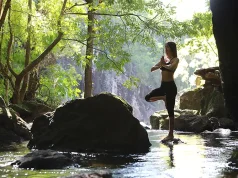Guatemala offers an abundance of diverse attractions, making it a destination where a short visit simply isn’t enough. The country’s vast landscape is filled with opportunities for adventure, from hiking active volcanoes to delving deep into Mayan culture and exploring lush natural reserves. Planning the perfect trip here requires careful consideration of what experiences you want to prioritize.
And one location will always show up in your search of what to do and where to go in Guatemala: Lake Atitlán. Think of a giant “bowl” of a freshwater lake that’s situated between huge, cone-shaped inactive volcanoes in the southwest highlands of the country. It’s the deepest in Central America reaching 340 meters at an altitude of 1,564 meters and is surrounded by eleven small villages that are heavily influenced by Mayan culture (and booming tourism that’s taking over Guatemala and Central America for that matter.)
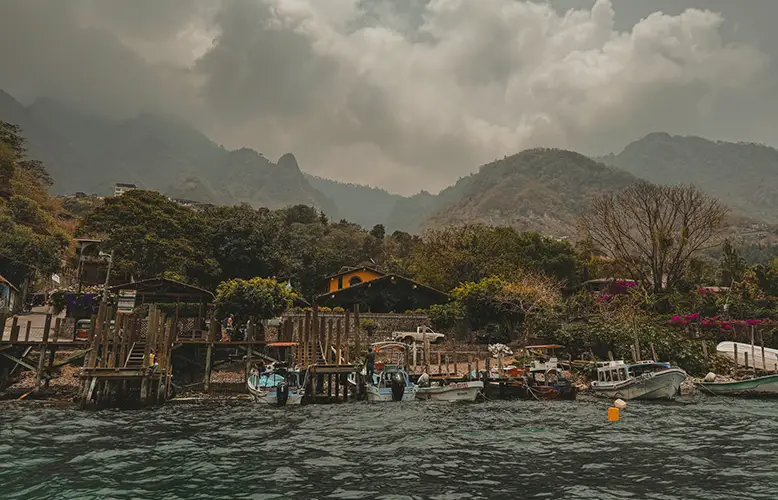
I refer to the lake as a “bowl” because it’s an endorheic basin, meaning it retains water without any outflow to other bodies of water such as oceans or rivers. This characteristic typically keeps water levels stable, but when changes do occur, they are notably impactful. A good example of this occurred in 1976, when a massive earthquake struck the region. This not only caused extensive damage and 26,000 casualties but also resulted in the splitting of the lake bed. The event led to a dramatic drainage of water from the lake, lowering its level by two meters in just one month! Other climatic events since then have similarly altered the lake’s composition, echoing the significant changes of the 1970s.
Because this lake is surrounded by “somewhat” inactive volcanoes, and was formed due to a super eruption 84,000 years ago, there are some special features that make this lake extremely exciting to visit. Which is why we were heading to this region in the first place. As pro scuba divers, we are constantly on the quest for off-the-trodden path in-water experiences and that’s how we found the lake. It’s one of the few places in the world that offers altitude dive training, where diving above sea level introduces a set of challenges that demand a more profound understanding of diving principles. Additionally, the lake provides a rare opportunity to engage in one exceptionally unusual activity: boiling eggs underwater using the heat from volcanic vents.
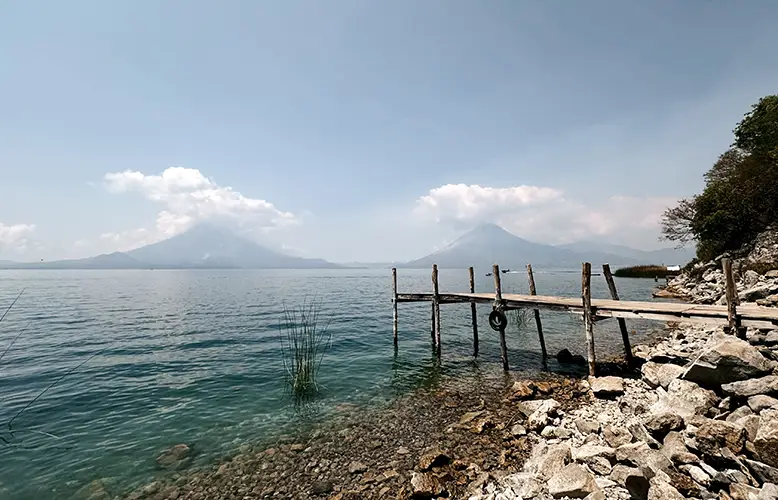
The volcanic activity around Lake Atitlán has created hot vents beneath the surface, and scuba divers can explore these vents up close. The lake hosts minimal marine life, with only a few species of fish present, making the hot vents one of the main attractions for divers. Additionally, the lake is home to the sunken ancient Mayan city of Samabaj. This archaeological site, now protected, adds a layer of historical intrigue to the area, although it is off-limits for recreational diving to preserve its integrity.
Discovered 15 meters below the surface, this pre-classical city, thriving between 400 BC and 250 AD, has been the focus of a multinational research effort led by Mexico’s National Anthropology and History Museum (INAH) since 2017. The project, supported by UNESCO’s Scientific and Technical Advisory Body, has drawn underwater archaeologists from across the globe. Utilizing advanced remote sensing technologies, the team has meticulously mapped and photographed Samabaj, revealing a well-preserved urban landscape complete with temples, plazas, and residential structures. The submerged city, originally situated on a small island, provides a unique glimpse into Mayan urban and spiritual life.
A volcanic event around 2,000 years ago is believed to have triggered seismic activity that raised the lake’s water levels, submerging the city. This sudden natural disaster likely forced the rapid evacuation of its inhabitants. Today, the cool, deep waters of the lake have preserved the ruins in pristine condition and the city’s architecture and artifacts might soon help identify whether the Tz’utujil or Kaqchikel Maya, two prominent groups at the time, were its original builders. Despite the Kaqchikel’s historical alignment with Spanish conquerors, which led to their eventual downfall, the remnants of their civilization remain untouched, telling tales of their past beneath Lake Atitlán’s surface.
Obsessing over the incredible history here, we were off to one of the small villages situated along the lake called Santa Cruz to stay at the famed backpacker hostel, La Iguana Perdida. Here’s the thing about traveling in Central America right now: if you want luxury you can find it, for sure. In fact, the recent tourism boom in the region means there are more upscale resorts than ever before. However, for those seeking a more genuine connection to the region, choosing accommodations like La Iguana Perdida can provide a more authentic experience. Here, travelers can immerse themselves in the local ambiance and truly engage with the heart and soul of the region.
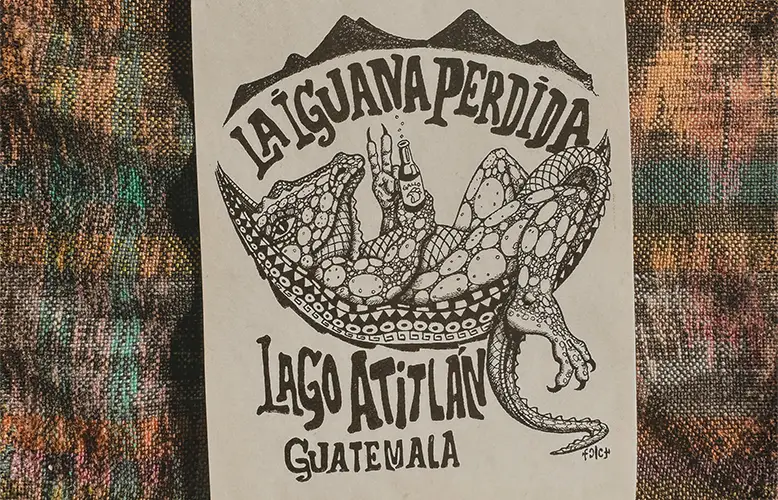
La Iguana Perdida hostel is designed to foster connections among like-minded travelers and to provide an immersive experience into the raw, untamed beauty of Guatemala. When founder Deedle Ratcliffe first purchased the property in 1995, she was captivated by its secluded location, serene beauty, and rich history—a charm she has strived to maintain despite the vast changes in global travel over the years. For example, there’s no wifi in communal areas but there’s a ton of activities to do that connect you with people and nature alike. And one of these activities happens to be diving in the lake!
The hostel’s dive center, ATI Divers, may not resemble a 5-star resort, but it serves as a gateway to unparalleled diving experiences that can’t be found anywhere else. After completing our altitude certification course on the first day, we were prepared and eager to dive the next. Our destination was a dive site aptly named Agua Caliente, or “Hot Water,” where we planned to carry out our unique experiment of boiling eggs underwater. Starting the day with a delicious smoothie breakfast, we soon headed to the boat, outfitted in quintessentially 80s dive gear, excited to discover the wonders beneath the surface of Lake Atitlán.
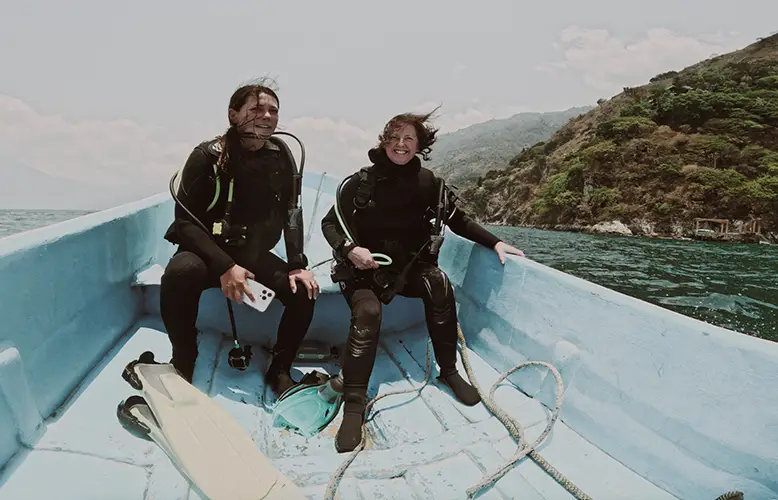
Taking the plunge, the visibility wasn’t anything to write home about. But we weren’t there to see features or have encounters of any kind. Immediately finding the hot vents, we stuck our hands into the silty bottom and found the perfect spot to rest our eggs, featuring drawn faces on them for added amusement. Surprisingly, passing us by were schools of Largemouth Bass, Common Carp and Black Crappie fish. To properly boil your egg, you need to leave it overnight on the hot vent and come back the next day to collect and ultimately, if you’re daring enough, eat.
Embracing the full experience, I eagerly seasoned and devoured all three of our special eggs, discovering a distinct taste reminiscent of what I guessed was volcanic ash. Whether this flavor was real or a product of my imagination, relishing in the moment, I left La Iguana Perdida feeling utterly fulfilled.
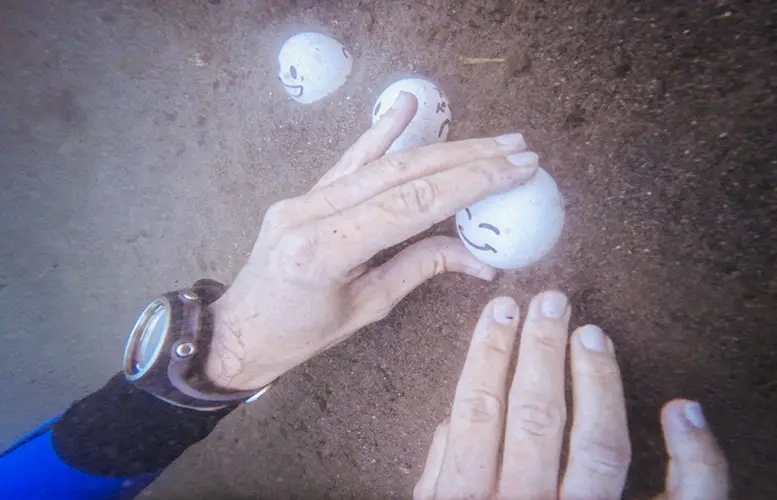
For those planning their next journey and seeking an experience that diverges from the typical, I wholeheartedly recommend spending a few days at Lake Atitlán. Devote some time to explore the surrounding villages and delve deep into Mayan culture for an enriching experience in this beautiful, yet somewhat underrated, region of Guatemala. And for those who have shared passions for diving and culinary adventures—Lake Atitlán offers an experience you won’t find anywhere else!




